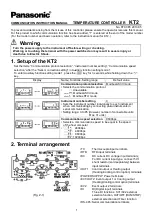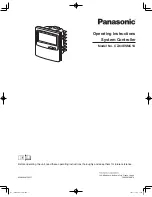
CHAPTER 5: SETTINGS
PRODUCT SETUP
F35 MULTIPLE FEEDER PROTECTION SYSTEM – INSTRUCTION MANUAL
5-143
5
The configuration menu allows a maximum of four ASDUs containing measurands.
Measurands are sent as a response to Class 2 requests, which are cyclic requests coming from the master.
TYPE IDENTIFICATION (TYP)
— The configuration field TYP indicates how many measurands are present in the corresponding
ASDU. Each ASDU can take either 4 or 9 measurands maximum, depending on the type identification (3 respectively 9). For
any change to take effect, restart the relay.
FUNCTION TYPE (FUN)
and
INFORMATION NUMBER (INF)
— These two fields form the Information Object Identifier of the ASDU
as defined in IEC 60870-103. For any change to take effect, restart the relay.
SCAN TIMEOUT (SCAN TOUT)
— This is the cyclic period used by the F35 to decide when a measurand ASDU is included in a
response. The measurand is sent as response to a Class 2 request when the corresponding timeout expires. The default
value 0 means 500 ms.
ANALOG #
— This field contains the actual measurand to be sent in the response to the master. The measurands can be
mapped using elements from a list of FlexAnalog operands. The measurands sent are voltage, current, power, power
factor, and frequency. If any other FlexAnalog is chosen, the F35 sends 0 instead of its value. Note that the power is
transmitted in KW, not W. Measurands are transmitted as ASDU 3 or ASDU 9 (type identification value set to measurands I,
respectively measurands II).
Each IEC 60870-5-103 measurands list ends at the first unconfigured ("Off") value. Any measurand assigned after the first
"Off" value is ignored.
At least one measurand per ASDU must be configured in order to configure the following ASDU. For example, the user can
configure only one measurand for each ASDU, but the user is not allowed to skip ASDU 2 and configure measurands in
ASDU 3.
For any change to take effect, restart the relay.
ANALOG # FACTOR
and
OFFSET
— For each measurand included in the ASDU, a factor and offset also can be configured. The
factor and offset allow for scaling to be performed on measurands. The final measurement sent to the IEC 60870-103
master is then "a*x + b," where x is the measurand, a is the multiplying factor and b is the offset. The master has to perform
the reversed operation in order to retrieve the actual value if such scaling is done. By default a = 1 and b = 0, so no scaling
is done if these values are left at their defaults. Examples of when scaling is appropriate are as follows:
•
If the measured value contains decimals and it is important to preserve the resolution. Since the format for
transmitting the measurand does not permit decimals, a factor a>1 can be applied before transmission. For example,
a frequency F=59.9Hz can be transmitted as Ft = 10 * F = 10 * 59.9 = 599. In this case a = 10, b = 0. The master receives
599 and has to divide by 10 to retrieve the real value 59.9.
•
If the measured value is larger than what fits in the format defined in IEC 103. The format defined in the standard
allows for signed integers up to 4095. By offsetting, unsigned integers up to 4096 + 4095 = 8191 are supported.
Scaling using factors <1 can be required in such cases. The calculation is outlined in the IEC 60870-5-103 chapter of
the UR Family Communications Guide. Two examples follow, where you decide factors a and b.
Example 1
: Nominal power Pn = 100 MW = 100000 KW (power is transmitted in KW)
Since P can be both positive and negative:
Transmitted power Pt = (4095/(Pn*2.4)) * P = (4095/(100000 * 2.4) ) * P
= 0.017 * P
a = 0.017
b = 0
ASDU 4 ANALOG 1
OFFSET: 0
Range: -32768 to 32767 in steps of 1
ASDU 4 ANALOG 9
Off
Range: FlexAnalog parameter
ASDU 4 ANALOG 9
FACTOR: 1.000
Range: 0.000 to 65.535 in steps of 0.001
ASDU 4 ANALOG 9
OFFSET: 0
Range: -32768 to 32767 in steps of 1
















































